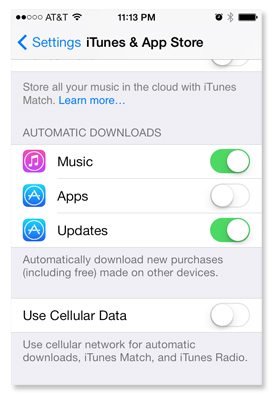
It’s easy to get caught up in the aesthetics of iOS 7. While the shift from skeuomorphic to flat design is a big one, there’s more to the update than pastel colors and clean font. Evernote’s CEO seems to think so, at least. He told TechCrunch that the release of iOS 7 makes for “the biggest day in technology ever.”
That seems a bit dramatic, so I turned to iOS expert TJ Fallon, a developer who’s been making iPhone and iPad apps since 2009. He’s built applications for brands from Nickelodeon to Walgreens and now works as an iOS developer at Vokal Interactive. Here are his thoughts on what iOS 7 will mean for the app industry.
Autoupdate is iOS 7’s “Gamechanger” Feature
“Autoupdate is the biggest feature that people won’t notice,” Fallon said. “It will make apps better. Bugs will be fixed as soon as developers can get them to Apple.” For the user, flipping the autoupdate switch means that the update badge won’t continuously stack up above the App Store icon. More importantly, for developers it means that apps can be incrementally improved without any action from the user. We all know that guy who never updates his apps, right?

Apps can be enhanced with movement
“There’s the UI dynamic stuff, too, which is cool,” Fallon said. “All the interfaces will feel more dynamic with movement that is more realistic.” To see what he’s talking about, open up iOS 7’s messaging app and watch how the speech bubbles compress as you scroll up and down.
Adjusting for screen size is simpler
“With autolayout, it’s a lot easier to build dynamic UIs that you sort of build once and then teach it how to stretch itself for multiple screen sizes,” Fallon said. “Before you had a little bit of control over how things would stretch. Now you have much more control. With iOS 6 you could anchor things to the top of the screen; now you can anchor other things to other things, like text to a button.”
iOS’s unreal adoption rates
Features aside, one thing is for sure about iOS 7: iPhone and iPad users can’t wait to get their hands on the new software. “In general, the adoption rate for software is really slow … really slow for Android, but not as bad for iOS. Nowadays we have a lot of hard data about iOS version usage,” Fallon says. The data he’s referring to is pretty astonishing. According to a study by Crittercism, iOS 7 will have an adoption rate of 80% by December.
The developer + brand relationship
“On the business side, you can now transfer apps between developers,” Fallon pointed out. This means that it’s easier to sell an app, for example from a developer to a brand. “Rather than the source code, you can sell the app itself on iTunes. That way you don’t have to worry about changes to the app, and you don’t have to re-release it in the App Store.”